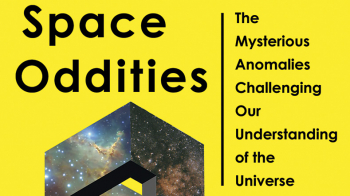Antimatter: What It Is and Why It’s Important in Physics and Everyday Life, By Beatriz Gato-Rivera, Springer

Antimatter captivates the popular imagination. Beatriz Gato-Rivera, a former CERN fellow in theoretical physics and now a researcher at the Spanish National Research Council, recently published a noteworthy book on the subject, entitled Antimatter: What It Is and Why It’s Important in Physics and Everyday Life. Substantially extending her text Antimateria, from the outreach collection “Qué Sabemos De”, this work will also be of interest to experts, thanks to well documented anecdotes of historical interest.
Gato-Rivera sets out with a detailed exploration of the differences between atoms and antiatoms, as well as of matter–antimatter annihilation, motivating the reader to delve into a fairly complete introduction to particle physics: the concepts that underpin the Standard Model, and some that lie beyond. She then focuses on diverse aspects of antimatter science, beginning with the differences between antimatter, dark matter and dark energy, and the different roles they play in the universe. This touches upon the observed accelerating expansion of the universe. In particular, Gato-Rivera discusses dark-matter and dark-energy candidates, attempts to detect dark matter and its relation to the fate of the universe. She also carefully explains the distinction between primordial and secondary antimatter, and their roles in cosmology.

Next up, a historical chapter reviews the major landmarks of the discovery of antimatter particles, from elementary antiparticles to anti-hadrons, and anti-nuclei to antiatoms. In particular, the ground-breaking discovery of the first antiparticle, the positron, is described in excellent detail. In a separate appendix, Gato-Rivera passionately clears up a historical controversy about its discovery. The positron was first found in cosmic rays by Carl Anderson and later artificially produced en masse in particle accelerators. Gato-Rivera then turns to a detailed historical overview of cosmic-ray research, from balloon experiments to large-scale ground-based detectors, finally culminating in modern space-based detectors on board satellites and the ISS. The next chapter covers the production of antimatter by particle collisions in accelerators at high energies, including a brief history of the facilities at CERN.
The focus is then put on one of the most interesting and important conundrums in particle physics and astrophysics: the apparent huge asymmetry between matter and antimatter in the observed universe. This touches upon the processes of the primordial creation of matter and antimatter, and on the open question of whether anti-stars, or even anti-galaxies, could exist somewhere in the universe.
Gato-Rivera returns to Earth to discuss current experiments in particle physics such as those at CERN’s Antimatter Factory, asking whether antiatoms really have the same properties as atoms, at least as far as their excitation spectra and gravitational pull is concerned. The author doesn’t shy away from popular questions such as whether antimatter anti-gravitates and would float up away from Earth. While the answers to these questions are firmly predicted in theory, there could be surprises, like the discovery of CP violation in the 1950s, so it is important to actually test these fundamental properties.
Sceptical words dash hopes of using antimatter as an energy source
The book finishes by exploring practical uses of antimatter in everyday life, such as the use of PET scanners to detect positrons emitted from short-lived radioactive substances administered to patients. The same principle is also used in material analysis, for example to test the mechanical integrity of turbine blades. But sceptical words dash any hopes of using antimatter as an energy source: the effort of artificially producing a single gram of antimatter would be prohibitive.
Gato-Rivera’s semi-popular text is comprehensive and well structured, with a minimum of mathematical expressions and technicalities. It will be most profitable for a scientifically educated audience with an interest in particle physics, however, experienced researchers who are interested in the history of the subject will also enjoy reading it.







